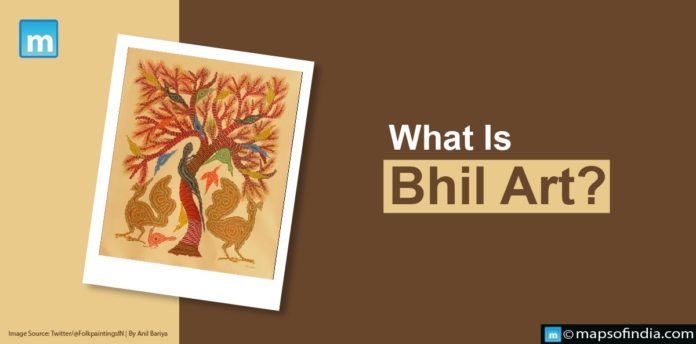Bhil art is a traditional folk art of the Bhil people, one of India’s largest indigenous groups. The Bhils are famous for their vivid and detailed paintings, frequently done on mud walls, floors, and textiles with natural pigments obtained from leaves, flowers, and rocks. Bhil art is distinguished by its bold, geometric designs and vivid primary colours. Bhil paintings frequently depict scenes from the Bhils’ daily lives, such as rituals, festivals, and connections to nature. Animals, birds, forests, flowers, and deities are common motifs in Bhil art. Bhil art is not simply beautiful, but it also holds significant cultural and spiritual meaning for the Bhil people. Art is a way for the Bhils to connect with their ancestors, celebrate their culture, and express their philosophy.
History of Bhil Art
Bhil art has a long and illustrious history that dates back millennia. The earliest specimens of Bhil art have been discovered on cave walls in Madhya Pradesh, India, and are thought to be over 10,000 years old. Bhil art has grown and adapted over the years to reflect the shifting social and cultural milieu of the Bhil people. Many Bhil artists, for example, began to infuse elements of European art into their works during the British colonial period. Bhil art is now more popular than ever before. Bhil artists’ work is currently being shown in galleries and museums worldwide, and their paintings are in high demand among collectors.
Types of Bhil Art
Traditional Bhil art is made with natural colours and is commonly found on mud walls, floors, and textiles. Traditional Bhil art is distinguished by its vivid geometric patterns and primary colours. Contemporary Bhil art is done utilising a range of materials, such as acrylic paint, oil paint, and watercolour. Contemporary Bhil artists frequently experiment with new techniques and styles, although they are deeply anchored in the Bhil art tradition.
Significance
Bhil art is essential for a variety of reasons. For starters, it is a beautiful and unique art form that reflects the Bhil people’s rich culture and tradition. Second, for the Bhil people, art is a vital means of self-expression. The Bhils use their art to communicate their story, celebrate their way of life, and connect.
Third, Bhil art maintains the Bhil people’s culture and traditions. Bhil art is an important source of resilience and hope for the Bhil people in a world where indigenous traditions are frequently disregarded and threatened.
Bhil Art Today
Bhil art is now more popular than ever before. Bhil artists’ work is currently being shown in galleries and museums worldwide, and their paintings are in high demand among collectors. Bhil art is also used to raise social and environmental consciousness. Some Bhil artists, for example, use their art to raise awareness about climate change and deforestation. Bhil art is a colourful and dynamic art form constantly evolving and inspiring. It demonstrates the Bhil people’s tenacity and inventiveness.




